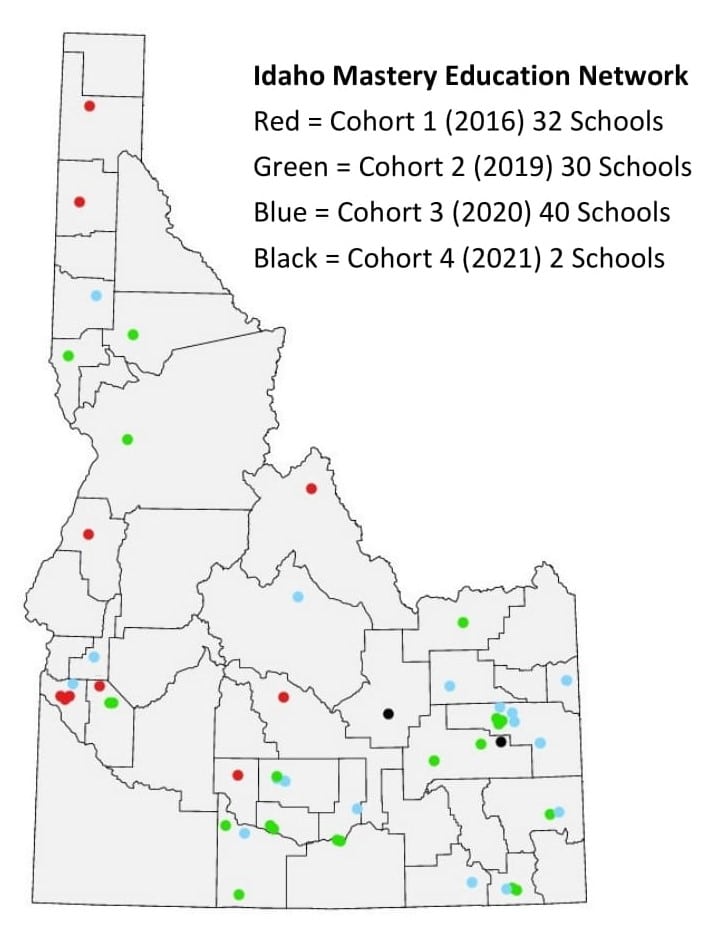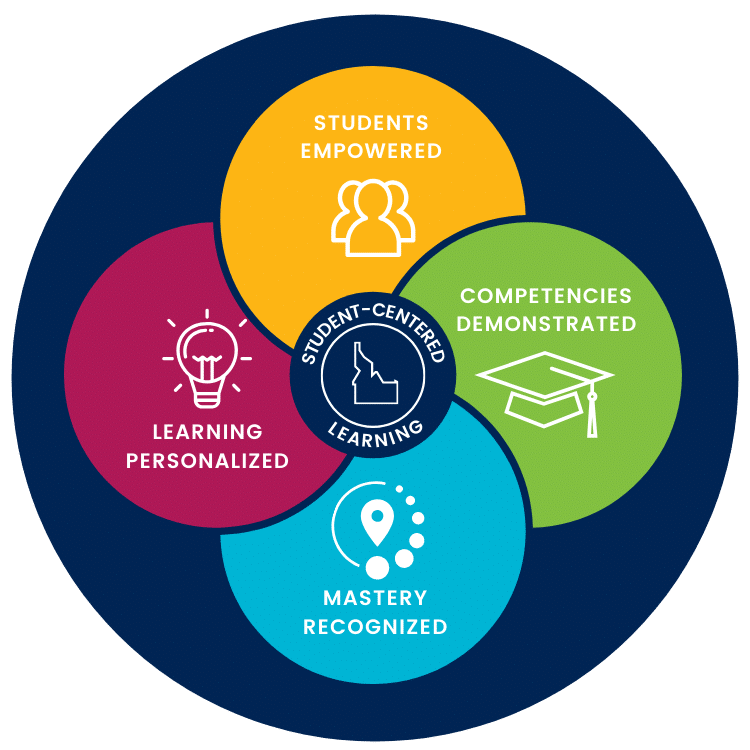Synthesizing the Learning of the Idaho Mastery Education Network
CompetencyWorks Blog
 It’s been over three and a half years since Chris Sturgis wrote a 10-piece series on Mastery-Based Learning in Idaho. Mastery-based learning is going strong, with over 40 schools participating in the Idaho Mastery Education Network (IMEN) in 2021-2022 and over 100 since 2016. The recently updated Idaho Mastery-Based Education webpage captures both five years of IMEN learning and the future potential for student-centered learning in Idaho. Here we revisit the story of mastery education in Idaho, highlight recent work, and look with hope towards building and scaling the movement.
It’s been over three and a half years since Chris Sturgis wrote a 10-piece series on Mastery-Based Learning in Idaho. Mastery-based learning is going strong, with over 40 schools participating in the Idaho Mastery Education Network (IMEN) in 2021-2022 and over 100 since 2016. The recently updated Idaho Mastery-Based Education webpage captures both five years of IMEN learning and the future potential for student-centered learning in Idaho. Here we revisit the story of mastery education in Idaho, highlight recent work, and look with hope towards building and scaling the movement.
(A note on terminology: Idaho statute uses the term “mastery-based education.” Here we also use the terms “mastery-based learning” and “mastery education” interchangeably. We understand these terms to be synonymous with other terms including “competency-based education,” “competency-based learning,” and “competency education.”)
Let 1000 Flowers Bloom
In 2016, the original IMEN incubator cohort embarked on an exciting adventure. The launch brought 32 schools from 19 districts together to learn and explore as a cohort for three years. The enduring theme of this period was one of balance between autonomy and support. Schools in this trailblazing cohort were given license to work towards their own individual visions of mastery, while still receiving meaningful guidance, support, and cultivation from the State Department of Education and partners. As is often the case when autonomy and support are skillfully weaved together, this incubation period produced a wide range of growth across schools—it “let a thousand flowers bloom.”
With early blooms in full swing, we entered the summer growing season for IMEN. Mastery learning is now embedded in Idaho statute (see below), and more and more schools are embarking on their own journeys to explore what mastery means, within IMEN and beyond.
Harnessing the Beauty
With the expansion of IMEN to include a second cohort in 2019, it came time to capture the beauty of these blooming flowers. The network had entered a new phase, in which excited educators wanted guidance on how to get started and which direction to head in. We needed a road map, based on the statute, to define what “mastery education” is in practice and how we might stage the journey of transformation.
During the 2019-2020 school year, the State Department of Education and its technical support partner, reDesign, began to synthesize everything we’d learned throughout the incubation period into the next phase of support for Idaho educators. Our goals were to include:
- systems-level guidance for each stage in the change process and in each domain of mastery
- curation, branding, and publishing of high-quality assets
This work produced three important resources:
- The Idaho Mastery-Based Education Framework
- The Idaho College and Career Readiness Competencies (ICCRC)
- The Idaho Mastery-Based Education Staging Guide
 The Idaho Mastery-Based Education Framework
The Idaho Mastery-Based Education Framework
This framework seeks to communicate the outcomes of mastery-based education in accessible language and deliver a clear message: that students and their learning need to be centered in our efforts. Always.
The Idaho College and Career Readiness Competencies (ICCRC)
If mastery-based education aims to empower students, personalize learning, integrate competencies, and recognize mastery, it’s essential that students are allowed to advance as they demonstrate their learning without the constraints of time, place, or pace. This, in turn, makes a set of clear competencies indispensable to any effort in mastery-based education. That’s why we produced the Idaho College and Career Readiness Competencies (ICCRC).
Building on the foundational competencies adopted in 2017 by the Idaho State Board of Education, which recognize “what a high school graduate will need to possess in order to lead a successful and meaningful life,” the ICCRC prepares students for work and life. Each competency is research-based and built out of component sub-skills that represent the abilities, processes, and strategies that make the competencies achievable for students. Each sub-skill is also complemented by a progression of performance-level descriptors—positively-framed, developmentally appropriate, and student-friendly “I can” statements that represent specific and observable actions and behaviors that become more sophisticated with each subsequent level.

The ICCRC goes beyond typical grade-level standards and instead provides a model for the transferable knowledge, concepts, and skills that will prepare students for their adventures beyond the walls of the classroom. Although crafted specifically for Idaho, the ICCRC is based on the National Association of Colleges and Employers (NACE) competencies and therefore provides a bridge between the State Board of Education, the workforce, Higher Ed, and the State Department of Education’s work with Idaho schools on creating entry points to mastery. As Superintendent Ybarra, a strong supporter of mastery-based education from the beginning, has noted, “Mastery learning supports our goal that all Idaho students persevere in life and are ready for college and careers. Together we collaborate to support student progress and achievement” (Staging Guide introduction).
The Idaho Mastery-Based Education Staging Guide
While the competencies offer a model of what we want students to learn and be able to do, the Staging Guide offers support on how to approach the shift towards a mastery-based model in terms of its practices, systems, and culture. It breaks down each element of the Idaho Mastery Learning Framework into a set of shifts, with related tools and resources, that culminate in a student-centered, mastery-based education system.
Rather than framing mastery education as a binary, the shifts identified in the Staging Guide reflect the reality that mastery education is more familiar and accessible than we often think. Whether or not a school has been explicit about calling it “mastery,” it’s likely that some pre-existing elements in any school’s practices connect to a culture of mastery. Moreover, each school’s journey (much like each student’s journey) depends on its work-to-date and its community’s goals. Rather than push a one-size-fits-all approach to change and implementation, flexible self-assessment and goal-setting tools help schools select the focus areas that work best for their community.
One example of a shift described in the Staging Guide comes from the “Students Empowered” section. In this shift, learner relationships go from being disconnected from adults and community to developing caring relationships that sustain and support. The guide provides indicators of this shift at the system and student learning levels.
Continued Cultivation
Despite the ongoing challenges presented by a global pandemic, the third cohort of IMEN began at the start of the 2020 school year with a new Explore cadre of 40 schools embarking on a year of exploration of the Idaho Mastery-Based Education Framework, College and Career Ready Competencies, and accompanying Staging Guide.
As we progress through the school year, grappling with uncertainty and new challenges, flexibility and adaptability continue to be guiding forces for Idaho educators. One of our priorities is to develop pathways towards focused entry points for each of the resources we’ve created. Our hope is that network sites serve as inspirational and accessible models of mastery education for schools interested in learning more about this exciting initiative and exploring the nuances of planning, designing, and implementing mastery education.
Our efforts continue to be grounded in statute, encouraging a student-centered learning focus in accessible ways, and offering guidance for how to bring systems and practices to the next level—for all Idaho learners. Cultivating growth takes time and is well worth the effort on behalf of each and every learner.
Learn More
- Mastery-Based Learning in Idaho
- The Sharp Ones: A Few Takeaways from Idaho
 Let’s Just Say It Out Loud: There Isn’t Enough Time To Cover All the Standards
Let’s Just Say It Out Loud: There Isn’t Enough Time To Cover All the Standards
Aaron McKinnon – After 22 years of blowing things up in a middle school science classroom, Aaron transitioned to the Idaho State Department of Education as the Science Coordinator. A short time later, he was asked to become the State’s Mastery-Based Education/Innovation Coordinator.
Laurie Gagnon is an Educational Designer at reDesign, where she works with school, district, and state practitioners to design and implement opportunities for students to explore their passions and learn what they need to reach their goals. Prior to becoming a reDesigner, Laurie was the Director of the Quality Performance Assessment Program at the Center for Collaborative Education. She began her professional life teaching English in Japan and teaching high school history in the United States. Follow @LaurieGagnon98
